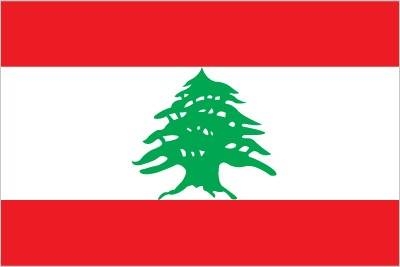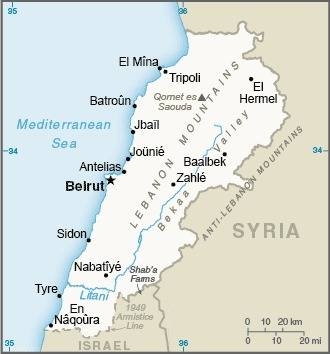151 Lebanon

Three horizontal bands consisting of red (top), white (middle, double width), and red (bottom) with a green cedar tree centered in the white band. The red bands symbolize blood shed for liberation, the white band denotes peace, the snow of the mountains, and purity. The green cedar tree is the symbol of Lebanon and represents eternity, steadiness, happiness, and prosperity.
Flag courtesy of the CIA World Factbook

Map courtesy of the CIA World Factbook

Located in Baalbek in Lebanon’s Bekaa Valley, the Temple of Jupiter, the largest Roman temple in the world, is part of the Baalbek temple complex that also includes the Temple of Bacchus. The complex became a UNESCO World Heritage site in 1984. Details of the temples construction – who commissioned or designed it, or exactly when it was constructed – are unknown. Work probably began around 16 B.C. and was nearly complete by about A.D. 60.
Photo courtesy of the CIA World Factbook
Government
According to Britannica, modern Lebanon is a unitary multiparty republic with a parliamentary system of government. Its constitution, promulgated in 1926 during the French mandate and modified by several subsequent amendments, provides for a unicameral Chamber of Deputies (renamed the National Assembly in 1979) elected for a term of four years by universal adult suffrage (women attained the right to vote and eligibility to run for office in 1953). According to the 1989 Ṭāʾif Accord, parliamentary seats are apportioned equally between Christian and Muslim groups, thereby replacing an earlier ratio that had favoured Christians. This sectarian distribution is also to be observed in appointments to public office.
The head of state is the president, who is elected by a two-thirds majority of the National Assembly for a term of six years and is eligible to serve consecutive terms. By an unwritten convention, the president must be a Maronite Christian, the premier a Sunni Muslim, and the speaker of the National Assembly a Shiʿi Muslim. The president, in consultation with the speaker of the National Assembly and the parliamentary deputies, invites a Sunni Muslim to form a cabinet, and the cabinet members’ portfolios are organized to reflect the sectarian balance. The cabinet, which holds more executive power than the president, requires a vote of confidence from the Assembly in order to remain in power. A vote of no confidence, however, is rarely exercised in practice. A cabinet usually falls because of internal dissension, societal strife, or pressure exerted by foreign states.
Lebanon is divided into muḥāfaẓāt (governorates) administered by the muḥāfiẓ (governor), who represents the central government. The governorates are further divided into aqḍiyyah (districts), each of which is presided over by a qāʾim-maqām (district chief), who, along with the governor, supervises local government. Municipalities (communities with at least 500 inhabitants) elect their own councils, which in turn elect mayors and vice-mayors. Villages and towns (more than 50 and fewer than 500 inhabitants) elect a mukhtār (headman) and a council of elders, who serve on an honorary basis. Officers of local governments serve four-year terms.
The system of law and justice is mostly modeled on French concepts. The judiciary consists of courts of the first instance, courts of appeal, courts of cassation, and a Court of Justice that handles cases affecting state security. The Council of State is a court that deals with administrative affairs. In addition, there are religious courts that deal with matters of personal status (such as inheritance, marriage, and property matters) as they pertain to autonomous communities. Stipulations in the Ṭāʾif Accord have led to the post-civil war establishment of a Constitutional Council, which is empowered to monitor the constitutionality of laws and handle disputes in the electoral process. Despite the country’s well-developed legal system and a very high proportion of lawyers, significant numbers of disputes and personal grievances are resolved outside the courts. Justice by feud and vendetta continues.
Civil / National Aviation Authority (CAA/NAA)
The Directorate General of Civil Aviation (DGCA) is one of the Directorates associated to the Ministry of Public Works and Transport (MPWT), which is governed by the Regulatory Decree number 1610 dated on the 26th of July 1971. The DGCA’s hierarchy is composed of the Directorate of Airports, the Directorate of Technical Exploitation, nine technical and administrative departments, the Airport Presidency and the Diwan (Court/Office of the directorate). Its mission is to regulate and operate Beirut Rafic Hariri International Airport (BRHIA), which is Lebanon’s portal to the world.
Airspace
SkyVector – Google Maps – ADS-B Exchange
ICAO countries publish an Aeronautical Information Publication (AIP). This document is divided into three parts: General (GEN), En Route (ENR) and Aerodromes (AD). ENR 1.4 details the types of airspace classes they chose to adopt from classes A through G. Lebanon AIP
Drone Regulations
REQUEST FOR A FILMING PERMIT USING A FLYING CAMERA
The general documents required for a filming permit using a flying camera:
A written request signed by the concerned party that includes:
- The subject and objective of the permit
- The type of the plane and camera and the serial number of each
- A schedule displaying the location and date of the filming.
- The phone number of the concerned party
The special documents:
- License issued by the air force
- A copy of the Identification Card belonging to the plane operator
- A copy of the passport and the entry stamp for the plane operator ( in case the operator was a foreigner)
- A picture of the plane and its serial number (scan)
The file processing mechanism, duration and fees
The file processing:
- The application should be presented via one of the following means:
- Personally to the Army Command – Secretary of General Staff
- Email: press@lebarmy.gov.lb
- Fax to the Directorate of Orientation: 01/424104
Duration for accomplishment:
- Minimum of 1 week after the date of presentation of the application with all the requested documents
Fees:
- No fees needed.
Advanced Air Mobility (AAM)
Short Essay Questions
Question 1
You have been hired by a Drone Startup Company. Your boss has immediately assigned this job to you.
They need you to prepare a one-page memo detailing the legalities of using a drone to film the Temple of Jupiter, pictured above.
They need you to mention any national laws and local ordinances.
They specifically want to know what airspace you will be operating in and whether or not you need an airspace authorization.
Does it matter whether or not you are a citizen of the country?
Lastly, there is a bonus for you if, as you scroll through this chapter, you find any typos or broken links!
Question 2
Do you need a certificate to fly UAS?
If so, how do you obtain one?
Are there fees associated with this?
If so, how much?
Question 3
May you operate beyond visual line of sight?
If so, what procedures must you follow?
Question 4
Does the country have UAM/AAM laws? If so, describe, citing the exact law.
Question 5
Are you aware of any new laws or policies not mentioned above? If so, describe, citing the exact law or policy.

